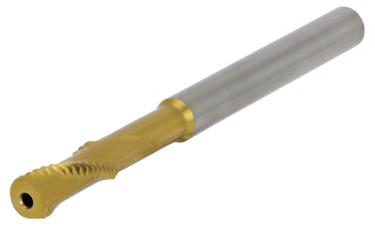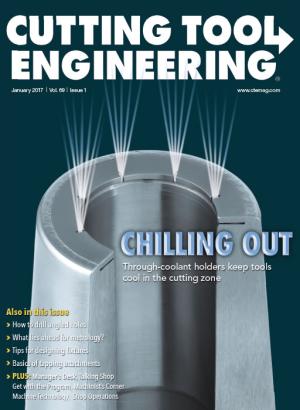Engineers at German carmaker Audi AG and toolmaker Emuge-Franken, with help from the Institute of Machining Technology at Dortmund (Germany) Technical University, have put a new spin on the way that threads are formed in materials such as aluminum. They call the process “helical thread forming.”

The punch-tap helical thread-forming tool was developed by Audi and Emuge-Franken. Image coutesy of Emuge.
Their “punch-tap” tool differs from a conventional or cold-forming tap. Instead of a continuous thread profile, the tool has two twisted rows of teeth that are offset 180° to each other. The tool head has two broaching teeth. When the tool punches—quickly—into a predrilled tap hole, it simultaneously turns on a steep helical path, and the broaching teeth generate spiral grooves on opposing sides of the hole. Then the spindle turns another 180° while the axial feed axis moves half a pitch, causing the teeth lining the sides of the tool to cut all of the threads at once. That 180° turn lines the broaching teeth back up with the helical grooves they cut, and the tool is retracted along that same path—which, if you are making a standard M6 thread that’s 0.59" (15mm) deep, is about 15 times shorter than the thread path itself would be. The entire process takes less than half a second, reducing threading time about 75 percent compared to cold forming, said Emuge.
According to Dortmund Technical University, test results indicated the geometry and holding forces of the internal threads punch-tapped in aluminum for an M6 thread is comparable to conventionally machined threads.
Audi had been the originator of the punch-tap technology; it brought in Emuge-Franken, Lauf, Germany, to partner on its development. With that in mind, the two companies agreed that the competitive advantage the technology brings should stay exclusive to Audi, at least for a while and at least in the automotive industry. Other automotive OEMs won’t be able to use it until January 2018. Automotive suppliers and parts manufacturers in other industries, however, reportedly will be able to use the punch-tap starting in January 2017.
For more information, contact Emuge-Franken’s U.S. office, Emuge Corp., West Boylston, Mass., at (800) 323-3013 or visit www.emuge.com.
Related Glossary Terms
- broaching
broaching
Operation in which a cutter progressively enlarges a slot or hole or shapes a workpiece exterior. Low teeth start the cut, intermediate teeth remove the majority of the material and high teeth finish the task. Broaching can be a one-step operation, as opposed to milling and slotting, which require repeated passes. Typically, however, broaching also involves multiple passes.
- feed
feed
Rate of change of position of the tool as a whole, relative to the workpiece while cutting.
- pitch
pitch
1. On a saw blade, the number of teeth per inch. 2. In threading, the number of threads per inch.
- tap
tap
Cylindrical tool that cuts internal threads and has flutes to remove chips and carry tapping fluid to the point of cut. Normally used on a drill press or tapping machine but also may be operated manually. See tapping.
- threading
threading
Process of both external (e.g., thread milling) and internal (e.g., tapping, thread milling) cutting, turning and rolling of threads into particular material. Standardized specifications are available to determine the desired results of the threading process. Numerous thread-series designations are written for specific applications. Threading often is performed on a lathe. Specifications such as thread height are critical in determining the strength of the threads. The material used is taken into consideration in determining the expected results of any particular application for that threaded piece. In external threading, a calculated depth is required as well as a particular angle to the cut. To perform internal threading, the exact diameter to bore the hole is critical before threading. The threads are distinguished from one another by the amount of tolerance and/or allowance that is specified. See turning.


